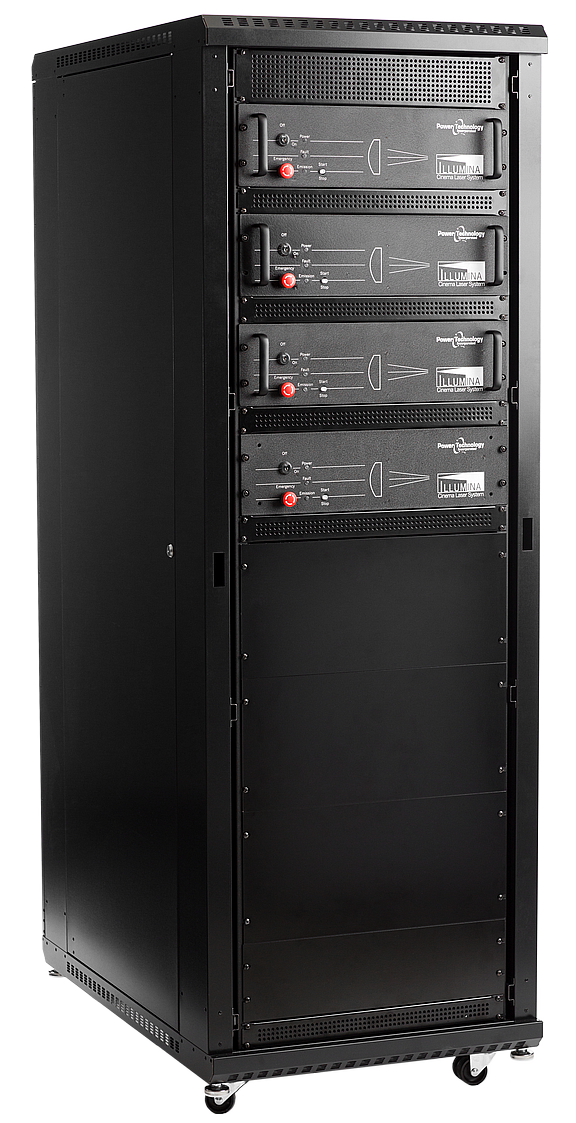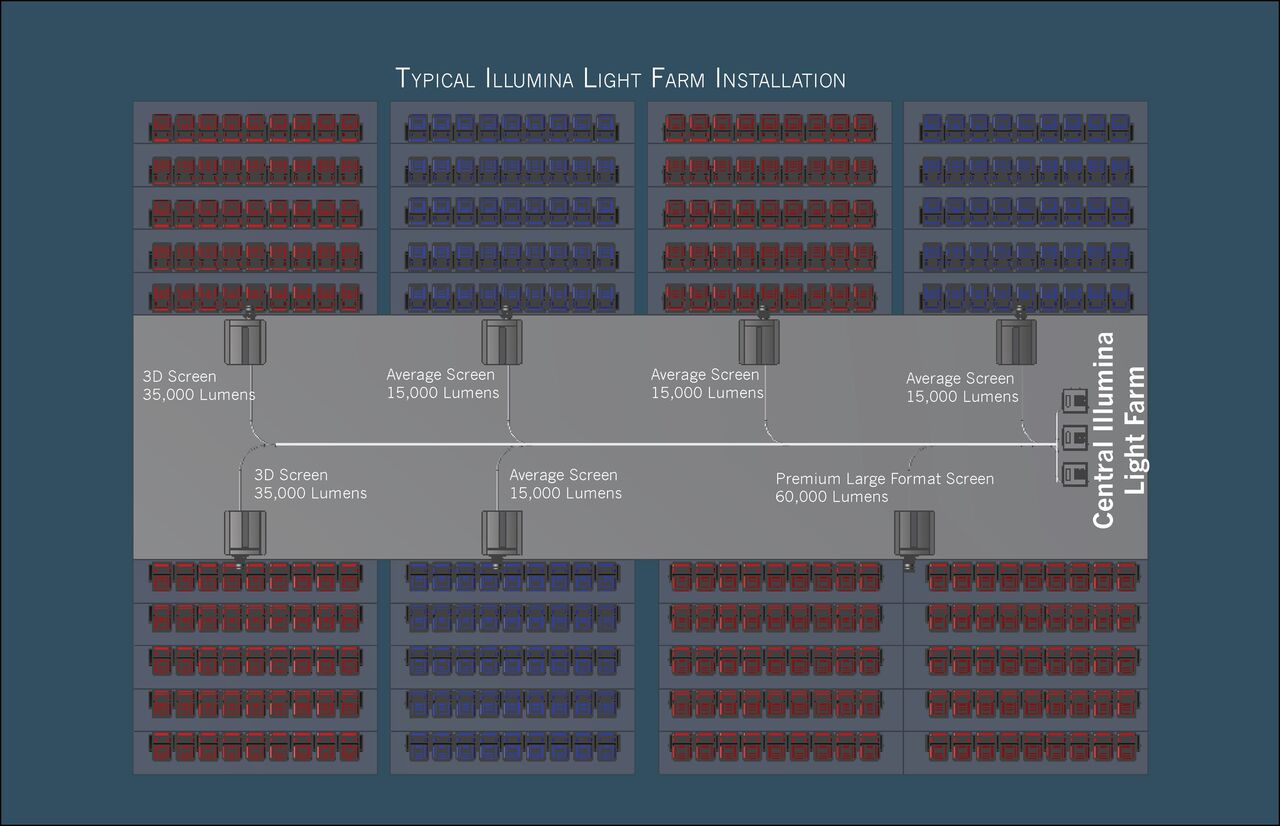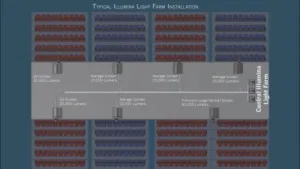Power Technology Inc. (PTI) has introduced a “laser light farm” designed to provide light to power multiple cinema screens (Power Tech Distributes Light). The light is delivered by fiber optics to each projector head from a central location, where all the RGB lasers are housed. It is an interesting concept that we discussed in more detail with VP of Engineering, Walter Burgess.

The concept of a central laser light farm is not new and was first proposed by Bill Beck at the Projection Summit some years ago when he ran a company called Laser Light Engines. PTI is the first to commercialize this concept, however.
The first question we asked Burgess was “why do this now?”. “We already have stand alone RGB laser light sources that are designed to power a cinema projector now,” explained Burgess. “But we were receiving inquiries from cinema exhibitors to install RGB laser light sources to multiple projectors or to cover entire facilities, so it made sense to offer the solution at this time.”
Burgess went on to note that PTI has been in the laser business for 45 years and recently completed a $1.5M Department of Defense program to mitigate speckle in lasers. “This knowledge and technology is built into the standalone and light farm products,” said Burgess, who noted that the reduction techniques uses multiple elements, some of which are located near the laser and some located in the projector head. “Our team has over 700 years of combined laser design and manufacturing experience, which I think is a lot more than others in the market,” noted Burgess.
Burgess explained that the light farm product is scalable, but they picked a practical upper limit for most installation scenarios. That means the solution can deliver up to 250K lumens that can be distributed over a variety of screens. This is sufficient, for a typical multiplex to have 10-18 screens with a few Premium Large Format (PLF) types, some 3D screens and the rest conventional 10-20K lumen screens – all driven from the light farm.
But if exhibitors install a light farm, what is their return on investment (ROI)? Burgess explained that to better understand this, they engage with exhibitors on a one-on-one basis because every location and every customer is different. “Every conversation about converting to laser illuminated projection begins with a virtual site survey to understand their layout, the types and number of projectors and even model numbers because not all projectors can be easily retrofitted for the RGB laser light,” said Burgess. “We also need to understand their market and business model. We believe that RGB cinema laser projection can demand a small up charge.” When asked what he thought this amount could be, he thought $0.50 to $2.00 seemed reasonable, but that depends upon the exhibitor and their local market.
The company is also supporting laser conversions by providing marketing support to upgraded locations to help the exhibitor justify the premium ticket price. “Everyone who has been to a movie in the last decade knows the amazing ‘THRUUUMMM’ sound tied to the THX branding. That sound means you’re going to be blown away by what you hear. We want to support exhibitors in the same way so when people see ‘Illumina Laser Projection’ they know they are in for a treat!” added Kristopher Hesson, Marketing Manager for Power Technology.

In addition to the potential for a revenue increase, exhibitors will save a lot on the expense side. Here, there are a number of elements to consider that are quite variable from cinema to cinema.
First is the savings in the cost of the lamps. Exhibitors can pay anywhere from $500 to $2,000 for a lamp, depending upon volumes and wattage. They can last from 500 to 1500 hours typically, again depending upon how the theater manages lamp replacements. Burgess noted that this is the biggest component to the cost savings.
The RGB laser light solution is also much more efficient, which means the exhibitor will save on electricity – up to half the cost to power Xenon lamps. And, there is far less heat to exhaust and air conditioning costs, so that also contributes to the ROI.
Burgess also pointed out another ROI factor that is not often discussed – extending the operational life of the projector. “By removing the Xenon lamp from close proximity to the projector, we allow the projector electronics to run a lot cooler, which means the projector should last longer as well. That means the cost of the projector can be spread out over more years and the exhibitor can stretch out replacement purchases. “Heat has an adverse impact on electronics. Since laser illuminated projection produces half the heat of a Xenon bulb, we reduce the temperature of the projector electronics and significantly extends the life of the projector” Burgess added.
Burgess explained that all of the ROI calculations are very dependent on the specifics of the exhibitor, so it is hard to offer a blanket calculation. But when pressed, he said the numbers typically indicate a 3-5 year payback period. Pricing is also a sensitive issue, but it is below competitors, conceded Burgess.
While PTI claims the light source can be located “dozens of meters” from any single projector, installing the light farm in a central location within the multiplex makes the most sense to reduce the length and cost of fiber optics.

As for performance, the solution today is a 3 primary (3P) configuration, but a 6P solution is in the works to support spectral 3D screens. As with all RGB laser solutions, the color gamut can extend well beyond the standard DCI-P3 color gamut. Burgess says the PTI solution can achieve more than 95% (by area) of the BT 2020 color gamut.
PTI is happy to reveal more details on its solution and work with potential customers, but prefers to do this under an NDA, so contact them if you want to get your site evaluated. (CC)

